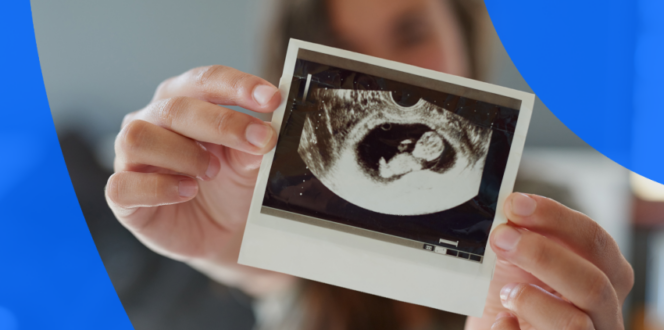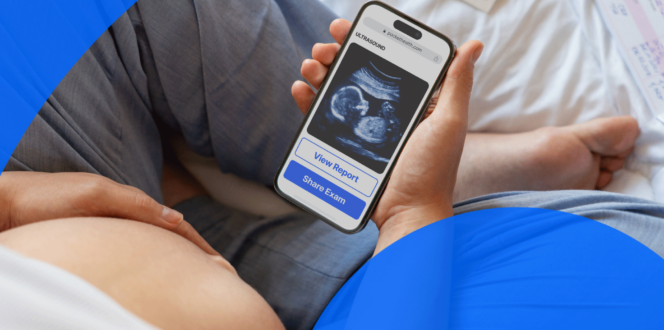What to Know About a Twin Pregnancy Ultrasound

If you’re expecting twins, you’re probably excited about your upcoming ultrasound. You may also have a lot of questions. This guide will cover when you can expect to see multiples on an ultrasound, the different types of twins and how they’re identified and preparations and expectations for your scan.
In many cases, your doctor will go over your ultrasound results with you at your follow-up appointment. For patients wanting early access, PocketHealth informs you the moment your finished report is uploaded, enabling you to securely view, save and even print your scan anytime you like.
When do twins show up on an ultrasound?
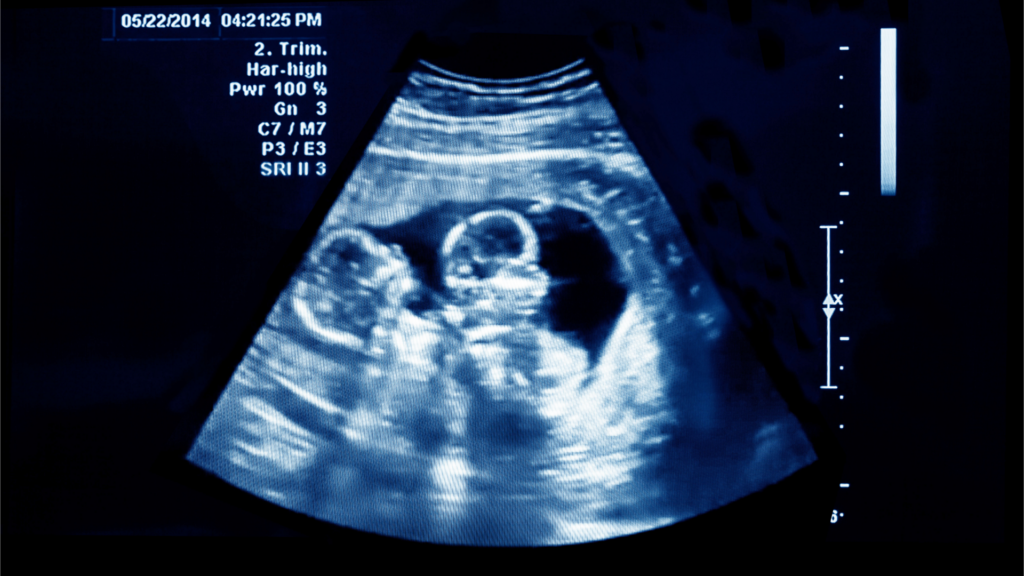
Here are some commonly asked questions about when your twins may be seen on your ultrasound scans.
How early can you see twins on an ultrasound?
The earliest you can typically expect to see twin fetuses on an ultrasound is around six weeks. Most patients have their first ultrasound to confirm gestational dating between six and thirteen weeks. The doctor should be able to confirm multiples at this time.
How often are twins missed on the first ultrasound?
The earlier you have your ultrasound, the greater the chance your multiples might be missed, though usually the ultrasound tech can see signs of twins even at a six-week scan. However, if the twins are sharing one amniotic sac instead of developing their own or if one fetus is hidden behind the other, they may be missed on your first scan.
Can an ultrasound miss twins at 20 weeks?
It is extremely unlikely and rare that your twins will be missed by their 20 week ultrasound. By now the fetuses are large enough for the sonographer to evaluate organs, bones and other anatomy. The twins will be too large to overlook.
Different types of twins and how they appear on an ultrasound
One of the first questions you might have is whether you’re expecting fraternal or identical twins. Since these types of twins appear differently on an ultrasound, your doctor can often identify which type you’re having. It’s important to understand that fraternal (dizygotic) twins develop when two separate eggs are fertilized by two different sperm, while identical (monozygotic) twins occur when a single fertilized egg splits into two embryos. Here is a brief overview of the variations for each type.
Identical twins
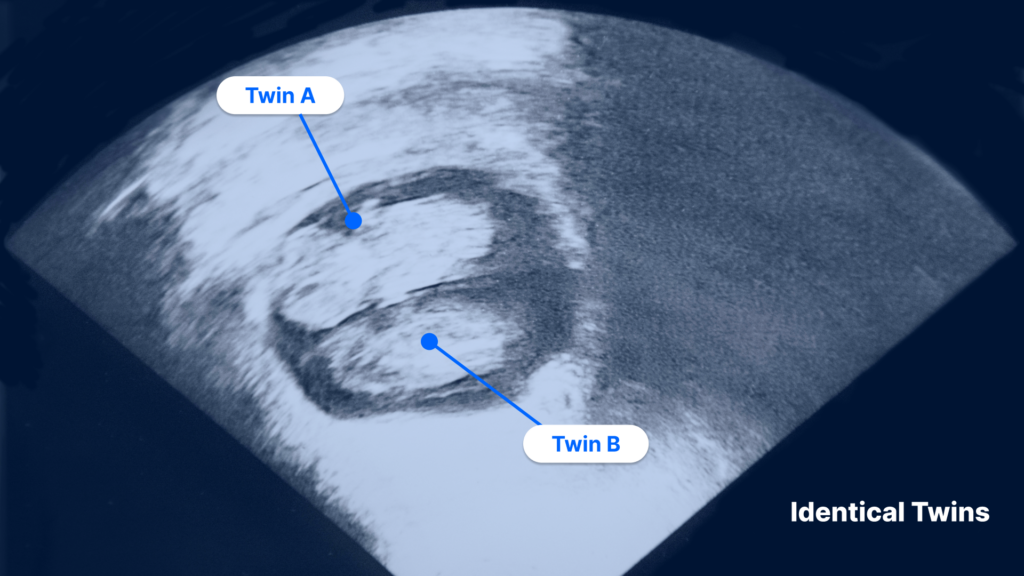
10 week ultrasound of identical twins
There are a few variations of identical twins:
- Mono-mono: Also called monoamniotic twins, these identical twins or triplets share the same placenta and amniotic sac. This is the least common type of twin and very rare for triplets. These types of twins also require more frequent prenatal observation to make sure their umbilical cords don’t tangle with each other. Fortunately, these cases are extremely rare and have a high rate of healthy births with frequent monitoring.
- Mono-di or mono-tri: Also called monochorionic diamniotic twins, these identical twins or triplets share the same placenta but each have their own amniotic sac. Despite the fact that they have the exact same genetic material, there may be small differences in how these genetics are expressed in each fetus. Meaning they can be technically identical with small physical variations.
- Di-di or tri-tri: Also called dichorionic diamniotic twins, this is when each twin has their own placenta and amniotic sac. The only thing they share is the womb. They can be identical or fraternal.
- Di-tri: Also called dichorionic triplets. Two of these triplets will be identical and one will be fraternal. The identical triplets will share a placenta, but each have their own amniotic sac, while the fraternal triplet will have its own placenta and amniotic sac. Like most cases of triplets, this is much less common than having twins or a single fetus.
Fraternal twins
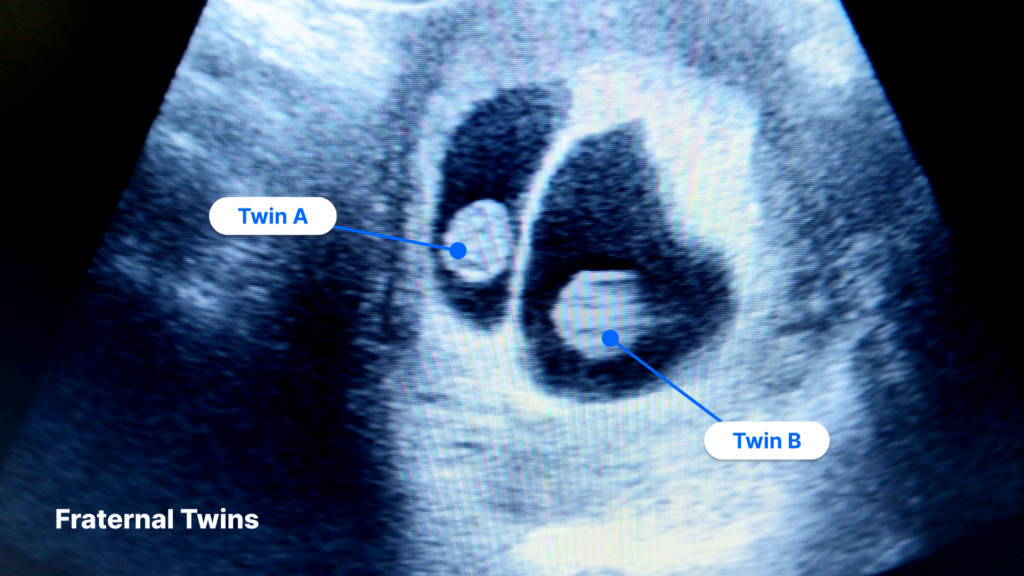
Ultrasound of fraternal twins
Fraternal twins are far more prevalent than identical twins. Identical twins share the exact same genetics as each other, but fraternal twins only share about 50% of their DNA. This is about the same shared genetics as non-twin siblings would have with each other. This means that fraternal twins can have a lot of variation, such as different eye and hair colors or even different sexes. Here are the types:
- Di-di or tri-tri: As already covered, this is when each twin has a separate amniotic sac and placenta. Though they can be identical, they are most commonly fraternal.
- Di-tri: As mentioned above, this refers to a situation where there are triplets, with two being identical and the third being fraternal.
- Trizygotic triplets: Also called fraternal triplets. This occurs when three separate sperm fertilize three separate eggs. Around 80% of triplets are fraternal.
Can one fraternal twin appear bigger than the other on an ultrasound?
Yes. Because fraternal twins only have roughly the same percentage of shared genetics as non-twin siblings (50%), a lot of variation is common.
How to tell if twins are identical or fraternal from an ultrasound?
Often, doctors will be able to determine the likelihood of twins being fraternal or identical based on whether they share a placenta. If they do, it is usually safe to assume they are identical. If they don’t, statistics indicate that they are fraternal about 75% of the time. To be certain, many parents wait until their babies are born and observe their physical traits to determine if they are fraternal or identical. For those seeking a definitive answer, a painless cheek swab can be sent to a DNA testing laboratory to determine genetic similarity.
What do twins or multiples look like on ultrasound?
Twins or multiples appear differently on an ultrasound depending on how far along the pregnancy is. In early ultrasounds, they may be harder to see clearly. As the pregnancy progresses, they become more distinct, with more visible features and differences.
Twin ultrasound pictures at 6 weeks
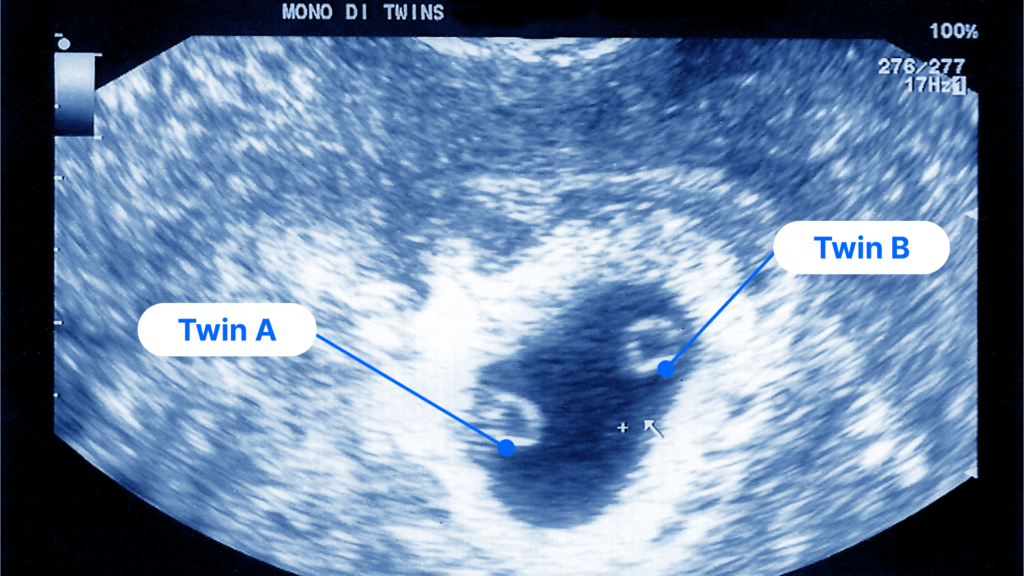
Identical twins on a 6-week ultrasound
This early ultrasound usually shows the fetal poles, yolk sacs, a tail-like backbone, paddle-like limbs, and other subtle formations. Typically, the doctor will be able to see if there are twins, but sometimes they can be missed at this early scan.
Can twins be missed on a 6-week ultrasound?
Yes. If one is “hiding” behind the other or just out of sight of the scanned area, they can be missed.
7 week ultrasound twin pictures
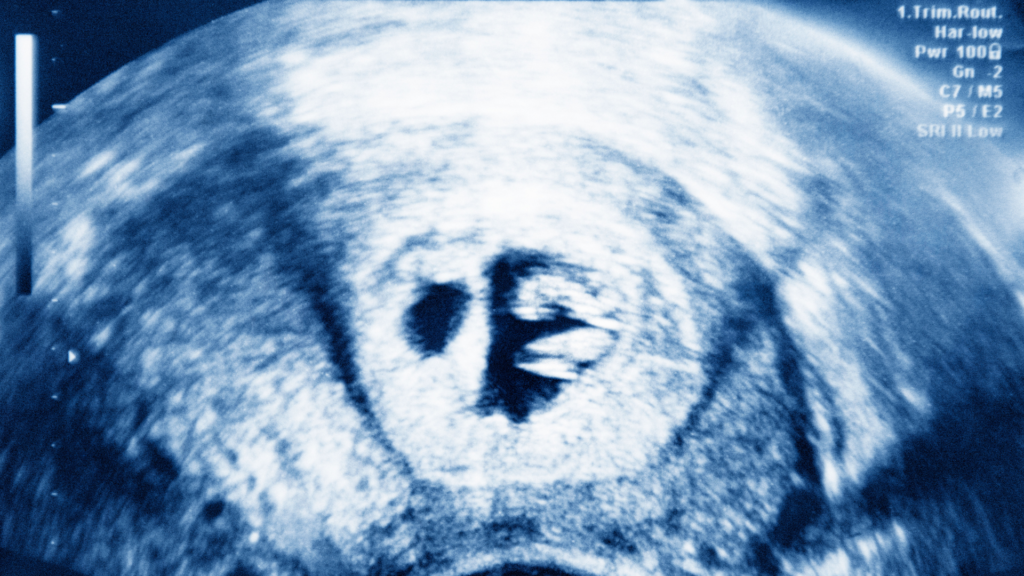
7-week ultrasound picture of twin fetuses
Average length at 7 weeks gestational age is only around a quarter inch long, so there won’t be a huge difference between the six and seven week scans. That said, sometimes this extra week of development enables the doctor to better spot things like yolk sacs and indications of multiples.
Can twins be missed on a 7-week ultrasound?
Yes. This is still considered an early ultrasound, so the second fetus can be trickier to see, though frequently doctors are able to detect it even at this stage.
Hidden twin on an ultrasound
Sometimes, one fetus can be hard to spot during early ultrasound scans, often because it is positioned behind its sibling. This is more common in twins who share the same amniotic sac, but it can happen with other types of twins too. By the time of the 20-week anatomy scan, all fetuses should be clearly visible, providing definitive answers about how many babies to expect.
How many ultrasounds do you get when pregnant with multiples?
Twins and triplets are generally considered higher-risk, so you’ll likely have more ultrasounds than usual throughout your pregnancy to monitor fetal health and development, especially leading up to your delivery.
Since twin embryos are generally smaller, it’s possible to miss them in early ultrasounds. With a hidden twin, one twin might block the other from view, especially among twins who share an amniotic sac. As they grow, however, the likelihood of missing sight of one of them declines.
What weeks of pregnancy are ultrasounds done?
The usual prenatal ultrasounds include a dating scan somewhere between 10 and 14 weeks, and an anatomy scan between 18 and 22 weeks. These ultrasounds confirm your pregnancy, monitor the fetal heartbeat, determine the gestational age and sex, and observe general growth and development.
You may also have an optional nuchal translucency (NT) ultrasound between 10 and 13 weeks. The NT measurements taken during this ultrasound evaluates the risk of Down syndrome and other congenital abnormalities.
When you’re pregnant with twins or multiples, you’ll likely have several additional scans, including:
- Chorionicity ultrasound to find out whether each fetus has its own chorion (one of the membranes that surround a forming fetus) and amniotic sac to determine types of multiple you’re carrying. This scan usually happens around 10 weeks.
- Doppler ultrasound to measure blood flow from the placenta through the umbilical cord and assess whether all the embryos are getting enough food and oxygen. This is performed if one twin or triplet appears bigger than the other(s).
- Cardiotocograph (CTG) to monitor your babies’ heartbeats. CTGs are another type of Doppler scan, and may be used to monitor the fetal heart rate during late pregnancy and labor.
- Growth scans in your second and third trimesters, to track progress and check your babies’ growth. These may be recommended every 2-6 weeks, depending on your circumstances.
Get fast access to your ultrasound results
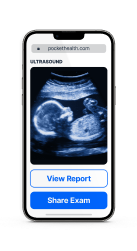
How to prepare for a twin pregnancy or multiples ultrasound
There are two main types of pregnancy ultrasounds: transabdominal, in which the technician coats your belly with lubricant and runs the transducer wand through it; and transvaginal, in which the lubricated transducer wand is inserted in the vagina. There are a few things you can do to prepare for your ultrasound:
- Bring a copy of your requisition: your requisition will specify exactly which type of exam you need. Having it with you will streamline your check-in process if your practitioner didn’t send it to the imaging clinic or hospital ahead of time.
- Know which type of ultrasound you’re getting: transvaginal ultrasounds are typically performed during early pregnancy. Since the embryos are so small, the transducer can capture more details and images from inside the vaginal canal.
- Wear loose and comfortable clothing: make sure to wear clothes you can easily get in and out of.
- Drink lots of water in the week leading up to your appointment: when you’re well-hydrated, your amniotic fluid is clear, which makes for better images.
- Book your appointment when your babies are most active: movement helps the technician capture more images. Another trick is to drink something cold and sugary just before your appointment.
- Arrive with a full bladder: Sound waves travel well through liquid, which makes it easier for the sonographer to capture the images you need.
- Have a support person join you: It often helps to have a support person with you, but check ahead of time. Not all hospitals or imaging clinics allow someone to accompany you in the exam room.
Questions to ask during and after your ultrasound
To stay fully informed on your pregnancy journey, don’t hesitate to ask the sonographer or technician questions before or during the appointment. You can ask about the procedure itself and everything that surrounds it, like:
- How long will the appointment last?
- Can anyone join me during the ultrasound? How many people?
- Can I take my own photos and videos during my appointment?
- How can I access and share my images/results?
- When will my practitioner receive the results?
The sonographer, who cannot legally discuss the results of your ultrasound with you, will prepare the images for a radiologist to review. The radiologist will interpret the images and send a report to your referring practitioner. You’ll get the results during a follow-up appointment and can ask different questions then, such as:
- Am I having twins? Triplets? Or more?
- Can we see all the embryos? Are they the same size?
- How many placentas are visible?
- What type of multiple (mono-mono, di-di, etc.) am I expecting? If it’s too early to tell, when will we know?
- How will my pregnancy differ from a singleton pregnancy?
- What other tests are recommended? Are those tests standard or optional?
- Are there any complications I should be aware of? If so, how will we monitor them going forward?
- Do I need to see a specialist?
- What changes should I make to my diet?
- What does this mean for my delivery?
How quickly can you get your ultrasound images and results?
If you want faster access to your medical records, whether it’s to see the report prior to your doctor’s appointment or to share the scan images with your family and friends, you can use PocketHealth.
With PocketHealth, you can securely access and permanently store your images and other health information all in one place. You can also use PocketHealth to conveniently share your ultrasound images with loved ones so they can easily see how your pregnancy is progressing.
If you find any of the terminology confusing in your ultrasound report, PocketHealth Report Reader can help. Report Reader provides easy-to-understand definitions of the terms in your ultrasound report so you can feel confident when discussing the results with your practitioner.
Getting ready for your double-feature
Finding out you’re having twins or multiples can be a lot to process and knowing you’re now having what’s considered a high-risk pregnancy can heighten your stress. But you can take comfort in knowing the additional ultrasounds will help ensure you and your babies are healthy and developing well leading up to delivery. Being prepared for what’s ahead in your unique pregnancy journey can help you feel more confident and in control.
PocketHealth is especially helpful for managing the added scans. It allows you to easily keep track of your babies’ growth and share these special milestone images with family and friends.
Published: July 27, 2023
Trusted by more than 800+ hospitals and clinics.


















